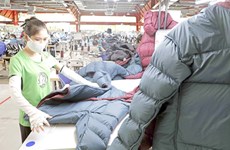Economic recovery begins, caution still key: experts
Experts have recognised signs of
recovery in Vietnam’s economy but are still warning the country to
remain cautious in executing economic policies to ensure growth will
not cause an imbalance in the macro-economy.
Experts have recognised signs of
recovery in Vietnam’s economy but are still warning the country to
remain cautious in executing economic policies to ensure growth will
not cause an imbalance in the macro-economy.
After suffering the brunt of the global economic crisis in the first quarter, Vietnam’s economy gathered momentum to revitalise the GDP.
From 3.1 percent in the first quarter, the GDP growth rate rose to 5.76 percent in the third quarter and is expected to reach 6.8 percent in the last quarter of the year. Backed by these rises, it is estimated to stand at 5.2 percent for the whole year.
Another bright sign was reflected in the national economy’s performance in its ‘backbone’ sector - industrial production, which recorded a 7 percent rise in production value in the first ten months of the year.
Retail sales in the past 10 months also grew by more than 10 percent against the 6.5 percent rate in the first quarter.
The flow of some 19 billion USD in foreign direct investment (FDI) into the country in the past 10 months was a surprise, as at the beginning of the year, the capital was forecast to reach 20 billion USD for the whole year. But with the current year-to-date figure, experts predict it will reach 25 billion USD for the whole year.
Dr. Vu Dinh Anh, who is Vice Head of the Finance Ministry’s Pricing and Market Science Research Institute, said these positive signs, coupled with endeavours to rein in inflation at no more than 7-8 percent, are good conditions to enable the national economy to grow in the next year.
However, the economist also warned that the country faces a possible risk of inflation next year, as the stimulus measures that have been adopted have driven total credits up by over 30 percent.
“High inflation could hit the country again if the prices of output materials on the world market go up,” Anh said, recommending the State adopt a reasonable exchange rate policy to “manage inflation, stimulate exports and attract foreign investment.”
Regarding the second economic stimulus package, the economist said it should focus on restructuring the national economy and re-directing economic development.
On the matter in question, Governor of the State Bank of Vietnam Nguyen Van Giau said that relevant agencies need to be cautious and take into account scientific calculations for deploying the second economic assistance package.
The Governor stressed that the first stimulus package “rescued” the economy from a “dangerous” phase, and the second package should focus on securing sustainable growth and ensuring social welfare.
On this topic, overseas Vietnamese economic consultant Bui Kien Thanh said the second stimulus package should concentrate particularly on developing rural areas, where 70 percent of the nation’s population live, and promoting small and medium-sized enterprises which have created up to 90 percent of the country’s jobs.
Though agreeing that the national economy lifted itself from the darkest moments of the crisis, the National Assembly’s Economic Committee also noted that risks still remain as macro-level balances have yet to be stabilised.
State budget deficit equals nearly 7 percent of the GDP this year while Government debt equals 40 percent of the country’s GDP, up from 37 percent last year, and it could reach 44 percent in the following year.
If no drastic measures to curb the State budget deficit are made, government debt will reach unsafe levels./.
After suffering the brunt of the global economic crisis in the first quarter, Vietnam’s economy gathered momentum to revitalise the GDP.
From 3.1 percent in the first quarter, the GDP growth rate rose to 5.76 percent in the third quarter and is expected to reach 6.8 percent in the last quarter of the year. Backed by these rises, it is estimated to stand at 5.2 percent for the whole year.
Another bright sign was reflected in the national economy’s performance in its ‘backbone’ sector - industrial production, which recorded a 7 percent rise in production value in the first ten months of the year.
Retail sales in the past 10 months also grew by more than 10 percent against the 6.5 percent rate in the first quarter.
The flow of some 19 billion USD in foreign direct investment (FDI) into the country in the past 10 months was a surprise, as at the beginning of the year, the capital was forecast to reach 20 billion USD for the whole year. But with the current year-to-date figure, experts predict it will reach 25 billion USD for the whole year.
Dr. Vu Dinh Anh, who is Vice Head of the Finance Ministry’s Pricing and Market Science Research Institute, said these positive signs, coupled with endeavours to rein in inflation at no more than 7-8 percent, are good conditions to enable the national economy to grow in the next year.
However, the economist also warned that the country faces a possible risk of inflation next year, as the stimulus measures that have been adopted have driven total credits up by over 30 percent.
“High inflation could hit the country again if the prices of output materials on the world market go up,” Anh said, recommending the State adopt a reasonable exchange rate policy to “manage inflation, stimulate exports and attract foreign investment.”
Regarding the second economic stimulus package, the economist said it should focus on restructuring the national economy and re-directing economic development.
On the matter in question, Governor of the State Bank of Vietnam Nguyen Van Giau said that relevant agencies need to be cautious and take into account scientific calculations for deploying the second economic assistance package.
The Governor stressed that the first stimulus package “rescued” the economy from a “dangerous” phase, and the second package should focus on securing sustainable growth and ensuring social welfare.
On this topic, overseas Vietnamese economic consultant Bui Kien Thanh said the second stimulus package should concentrate particularly on developing rural areas, where 70 percent of the nation’s population live, and promoting small and medium-sized enterprises which have created up to 90 percent of the country’s jobs.
Though agreeing that the national economy lifted itself from the darkest moments of the crisis, the National Assembly’s Economic Committee also noted that risks still remain as macro-level balances have yet to be stabilised.
State budget deficit equals nearly 7 percent of the GDP this year while Government debt equals 40 percent of the country’s GDP, up from 37 percent last year, and it could reach 44 percent in the following year.
If no drastic measures to curb the State budget deficit are made, government debt will reach unsafe levels./.












